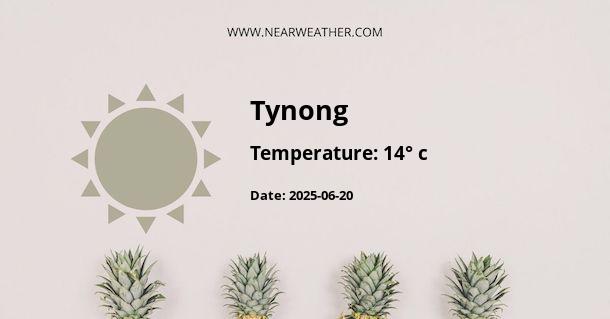Tynong, Australia: Climate and Weather Year Round
Tynong is a small town located in the Cardinia Shire, Victoria, Australia. It has a unique climate that is influenced by its geographical location and the surrounding topography. In this article, we will explore the climate and weather conditions in Tynong throughout the year, providing detailed and accurate information for visitors and residents alike.
Geographical Location
Tynong is situated in southeastern Australia, approximately 70 kilometers (43 miles) east of Melbourne. It is located at an elevation of about 100 meters (328 feet) above sea level, surrounded by rolling hills and agricultural land. The town also lies close to the western edge of the Gippsland Plain, which further affects its climate.
Climate Classification
Tynong falls under the climate classification of "Mediterranean" (Csb) according to the Köppen climate classification system. This means that it experiences warm to hot summers and mild to cool winters, with moderate rainfall throughout the year. The town's proximity to the coast also influences its climate, as it is exposed to the cooling effects of the Southern Ocean.
Temperature
The average annual temperature in Tynong is around 14°C (57°F). The town experiences distinct seasons, with summer being the warmest and winter being the coolest. During the summer months of December to February, the average maximum temperature ranges from 25°C to 30°C (77°F to 86°F), while the average minimum temperature ranges from 12°C to 16°C (54°F to 61°F). Winters, from June to August, are milder, with average maximum temperatures ranging from 12°C to 16°C (54°F to 61°F) and average minimum temperatures ranging from 4°C to 8°C (39°F to 46°F).
Tynong occasionally experiences heatwaves during the summer months, with temperatures exceeding 35°C (95°F) for short periods. It is important to stay hydrated and take necessary precautions during these hot spells.
Rainfall
Tynong receives an average annual rainfall of approximately 900 millimeters (35 inches). The town experiences rainfall throughout the year, with no distinct dry season. The wettest months are usually in autumn (March to May) and spring (September to November), with average monthly rainfall ranging from 60 to 90 millimeters (2.4 to 3.5 inches). The drier months are generally during the summer (December to February), with average monthly rainfall ranging from 30 to 40 millimeters (1.2 to 1.6 inches).
The rainfall in Tynong is evenly distributed, which is beneficial for the local agriculture and vegetation. The area is known for its fertile soils and is suitable for farming and horticulture.
Sunshine Hours
Tynong enjoys a moderate amount of sunshine throughout the year. On average, the town receives approximately 2,200 hours of sunshine annually. The summer months have the highest number of sunshine hours, with an average of 8 to 9 hours per day. In contrast, the winter months have fewer sunshine hours, ranging from 4 to 6 hours per day.
Wind
Tynong experiences moderate winds throughout the year. The prevailing winds come from the northwest and southwest directions. These winds can bring cool breezes during the summer months, providing some relief from the heat. It is essential to monitor weather forecasts and take necessary precautions during periods of strong winds, as they can occasionally cause damage to trees and infrastructure.
Frost
Tynong occasionally experiences frost during the winter months, particularly in low-lying areas and open fields. Frost can occur when temperatures drop below freezing point overnight. It is important for farmers and gardeners to take necessary measures to protect sensitive plants during these frosty periods.
Severe Weather Events
As with many parts of Australia, Tynong is susceptible to severe weather events such as thunderstorms, heavy rainfall, and bushfires. Thunderstorms can occur during the warmer months, bringing heavy rain, lightning, and strong winds. It is important to stay informed about weather warnings and follow any advice or instructions from local authorities during these events.
Tynong is also prone to bushfires, especially during the hotter and drier months. It is crucial to have a bushfire preparedness plan in place and follow any advice or evacuation orders given by emergency services.
Conclusion
Tynong, Australia, has a Mediterranean climate with warm summers, mild winters, and moderate rainfall throughout the year. It is important to stay informed about weather forecasts and be prepared for potential severe weather events. Whether you are visiting or residing in Tynong, understanding the climate and weather patterns will help you make the most of your time in this beautiful part of Victoria.
A - Tynong's Latitude is -38.083328 & Longitude is 145.616669.
A - Weather in Tynong is 11° today.
A - Climate Conditions in Tynong shows clear sky today.
A - Humidity in Tynong is 90% today.
A - Wind speed in Tynong is 5.83 km/h, flowing at 84° wind direction. today.
